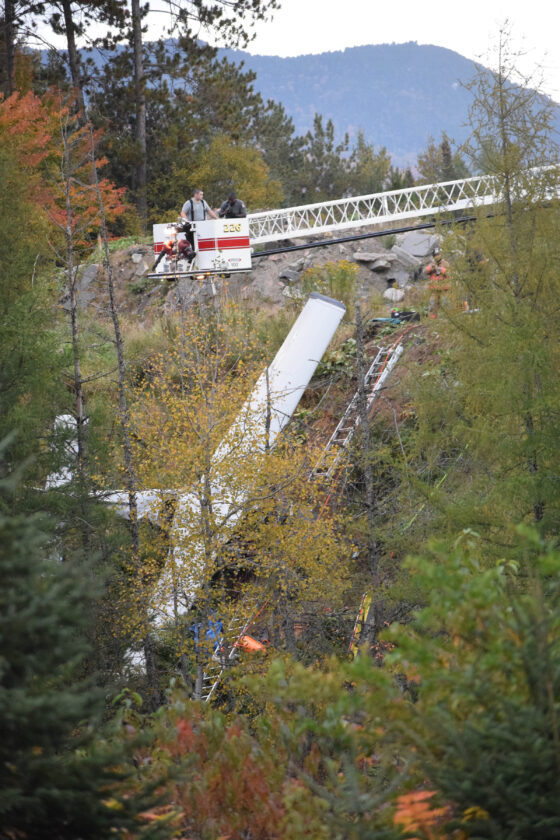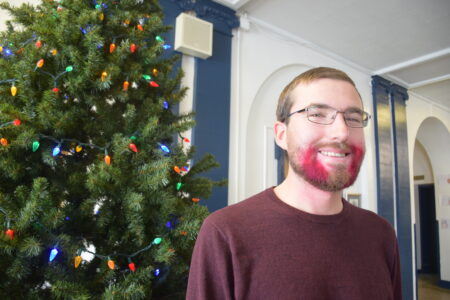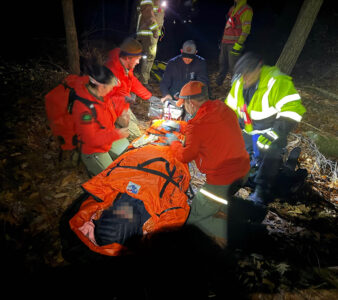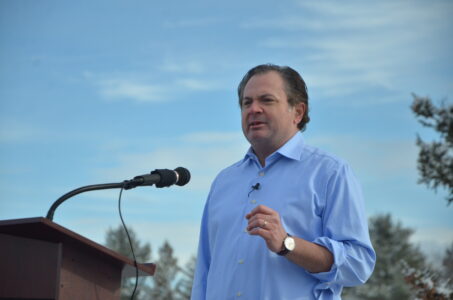Some answers, some unknowns on fatal 2023 plane crash
Report: engine failure, abrupt maneuver led to crash that killed Russ Francis, Richard McSpadden

Lake Placid volunteer firefighters at the site of the fatal airplane crash in Lake Placid on Oct. 1, 2023. (Enterprise photo — Aaron Marbone)
LAKE PLACID — Nearly two years to the day after a plane crash in Lake Placid left two dead, a report has been released detailing some of what led to the 2023 crash, but there are still some unknowns.
The report finds that a partial loss of engine power, an abrupt maneuver attempting to return to the runway and the Cessna operating outside of its center of gravity limit led to the plane’s crash into an embankment short of the runway.
The crash killed the plane’s pilot — former NFL tight end Russ Francis, 70, who had recently co-purchased the Lake Placid Airways scenic tour business — and passenger Richard McSpadden, 63, who was the senior vice president of the Aircraft Owners and Pilots Association, an aviation safety organization.
The tragic crash left ripples throughout the general aviation, football and local communities.
After two years of investigation, the National Transportation Safety Board released its final report on the crash on Sept. 30.
The report found that the engine stopped and started on takeoff and initial climb — experiencing an issue the NTSB was not able to identify. In the air, Francis attempted to turn the plane 180-degrees to return to the runway — a controversial maneuver colloquially known in the general aviation community as the “Impossible Turn.”
He had completed this maneuver in this plane several weeks before, when a baggage door was discovered open shortly after takeoff on a practice flight. But on the day of the crash, the turn came sooner, the aggressive low-altitude maneuvering caused a stall and the plane did not reach the runway.
The full report can be found at tinyurl.com/2yf6yjcx.
–
The crash
–
On Oct. 1, 2023, at around 4 p.m., Francis and McSpadden took off for a scenic photoshoot of the 1976 Cessna 177RG Cardinal owned and operated by Lake Placid Air Service for the AOPA’s Pilot magazine.
The photographer for the photoshoot had taken off several minutes earlier and was already in the air.
According to eyewitnesses, the Cardinal’s engine shut off for five seconds as they taxied to the runway and then restarted. The propeller also stopped and restarted. As the plane rolled down the runway before takeoff, a glider pilot on the ground said the propeller sounded like it was set to climb instead of takeoff. The glider pilot then heard the engine surge and then sound like it was not at full power on takeoff.
The glider pilot said the Cessna took 100 feet more to take off than the photographer’s plane. After it lifted off the ground, the glider pilot saw white smoke puff from the exhaust pipes and said the plane was climbing slowly.
The Cessna took a gentle left turn 300 to 400 feet above ground level to meet with the photographer’s plane. This plane’s pilot recalled that McSpadden said over the radio, “we have a problem and we’re returning to the airport.”
The Cessna took a sudden hard right to turn back to the airport — one mile away from the runway.
Halfway through the turn, the glider pilot said the Cardinal’s nose dropped.
The plane struck an embankment close to Recycle Circle Lane and the North Elba Athletic Fields with its right wing and nose about 15 feet below the top of a plateau, 440 feet from the end of the runway and 250 feet left of the centerline. It slid 30 feet down the cliff.
An eyewitness, Ryan Branchaud, told the Enterprise on Oct. 3 that he saw the crash while sitting on the front porch of his home nearby. He immediately jumped in his car and drove over to the crash site, along with a neighbor, Kevin Reynolds, and Lake Placid School fifth grade science teacher Jon Fremante. They attempted to open the door of the aircraft, diverted leaking fuel away from Francis and McSpadden and tried to keep both of them conscious while waiting for first responders to arrive. Both Francis and McSpadden died as a result of their injuries.
According to the report, an Essex County coroner found the cause of death for both men to be multiple blunt traumatic injuries.
–
Engine, center of gravity and stalls
–
Francis and McSpadden each had thousands of hours of flight time — Francis had around 9,000 and McSpadden had around 5,800.
“However, (Francis) had only about 10 hours of flight experience in the accident airplane make and model,” according to the report.
The Cessna was manufactured in 1976 and was most recently inspected six months prior to the crash. According to the airplane’s maintenance records, the engine had accumulated about 76 hours of operation since major overhaul.
The maintenance records did not show any discrepancies or abnormalities in the plane. An NTSB examination of the plane found some discrepancies. The hydraulic lifters had not been replaced during the last engine overhaul as required by the engine manufacturer — but they were not leaking. Two lifters had a slower bleed-down rate but the report says that would have little effect at higher revolutions per minute. Also, the extension portion of the fuel reservoir drain control was improperly installed, but could still be moved slightly.
“None of the discrepancies found were likely to have resulted in any preimpact failures or malfunctions that would have affected normal operation,” the report states.
It lists the cause of the partial engine power loss simply as “undetermined reasons.”
The NTSB estimated the aircraft’s weight and balance and found that the center of gravity was likely one inch forward of its limit.
Operating outside of center of gravity limits makes controlling the plane more difficult, often results in decreased performance and higher stalling speeds and makes the nose heavier.
The report said they could have added ballast in the rear to get better balance.
“The pilot’s failure to perform weight and balance calculations led to the airplane taking off outside its forward CG limit, which likely degraded the controllability of the airplane,” the report states. “The pilot’s subsequent aggressive use of the flight controls to turn back to the airport ultimately resulted in the airplane exceeding its critical angle of attack and entering an aerodynamic stall at an altitude from which a safe recovery by the pilot was not possible.”
Recovered GPS data from the flight shows that, 1,000 feet from the runway, the plane’s total energy reached a peak and began to decrease, which the report says is “consistent with a decrease in engine power.”
The 180-degree turn to return to the runway increased the “lift coefficient” sharply.
“The lift coefficient then exceeded the airplane’s expected maximum lift coefficient … which was indicative of an aerodynamic stall,” the report states.
–
The turn
–
Several weeks before the crash, on Sept. 17, Francis took a flight instructor on a practice flight in the Cessna Cardinal.
Upon takeoff, they heard a noise and felt a draft at 200 feet in the air. The instructor turned around and saw that the baggage door was wide open. Now at a height of 500 to 800 feet above the ground, Francis made an immediate “very steep bank” to the left and landed back on the runway.
The report said this maneuver was “similar in nature to the aggressive air turnback observed during the accident flight.”
Mike Ginter, who is now the AOPA Air Safety Institute’s senior vice president, released a video on the report of the crash in the institute’s “Early Analysis” series last week. McSpadden created the video series, which focuses on aviation crashes, what causes them and how to avoid them. Ginter said the “impossible turn” — a 180-degree turnback after engine failure on takeoff — is “risky.”
In 2021, McSpadden had produced a video for the ASI on the maneuver titled “Reality Check: The Runway Behind You.” The maneuver splits the general aviation community on if it should ever be attempted.
McSpadden found that the turnback can be done in certain aircraft, in the right altitude, in the right conditions with a skilled pilot trained for the maneuver.
He felt pilots should be trained to attempt it if necessary, but said numerous factors can impact results — wind, temperature, density altitude, runway length and technique.
“We’ve lost pilots training in these maneuvers due to the high potential for an uncoordinated stall and spin in the turnback,” McSpadden said at the end of the video.
One factor the NTSB identified was a higher-than-normal density altitude of approximately 2,758 feet above mean sea level, which would result in reduced aircraft performance and a slower climb.
–
Francis and McSpadden
–
Francis was drafted as both a pitcher for the Kansas City Royals in the 1974 Major League Baseball draft and as a third-string tight end for the New England Patriots in 1975. He went the football route. He was selected for the Pro Bowl during three consecutive seasons — 1977, 1978 and 1979 — and sat out the 1981 NFL season before playing six years with the San Francisco 49ers. It was with the 49ers that he would earn a Super Bowl ring in 1985. He retired in 1989 with 393 receptions and 5,262 receiving yards over his career.
When he was designated All-Pro, sports broadcaster and Francis’ friend Howard Cosell said he was “All-World.”
Aside from football, aviation was his true love.
At age 21, after growing up fascinated with flight, he walked 8 miles from the University of Oregon campus to the Eugene airport between classes and got some old timers to take him up in the air. He would sleep on a cot in a hanger and fly three times a day.
When he played for the San Francisco 49ers, he would fly his P-51 Mustang to practice and land in the stadium parking lot, upsetting head coach Bill Walsh.
He left behind a son, two daughters and a girlfriend.
To read more about Francis, go to tinyurl.com/yb65z985.
McSpadden, 63, was a pilot with an “infectious passion” for flight and aircraft safety. He started flying as a teenager and was a prominent voice in the general aviation community.
He had been a pilot with the U.S. Air Force and served as the commander and flight leader of the Thunderbirds demonstration team.
He had been with the AOPA since 2017, first as the executive director of AOPA’s Air Safety Institute and since 2020 as the senior VP.
McSpadden was a communicator with a loving following in the general aviation community.
He wrote many reports on crashes, which served as guides to others on how to avoid tragedy. His death in an airplane crash struck to the heart of the aviation enthusiasts who followed his work.
He left behind a wife, a son and a daughter.
To read more about McSpadden, go to tinyurl.com/394frtzp.





